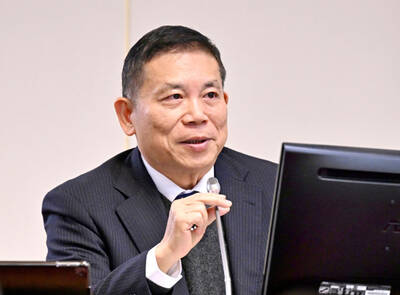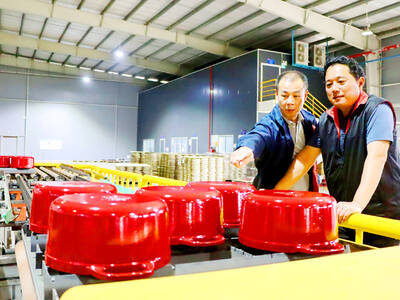Memorychip maker Winbond Electronics Corp (華邦電) yesterday said that this quarter would be its worst of the year in terms of average selling prices and factory utilization as customers signaled a pickup in demand for chips used in PCs and TVs amid falling inventory.
The Hsinchu-based chipmaker said it expects severe price cuts this quarter, with prices to remain at those levels throughout the year as oversupply and inventory corrections ease.
China’s reopening is expected to boost production there and spur a rebound in consumer spending in the world’s second-largest economy, Winbond said.

Photo: Grace Hung, Taipei Times
The growth spillover effect is expected to lift the global economy, it said.
“We expect the first quarter will be the bottom in terms of price erosion,” Winbond president James Chen (陳沛銘) told an online investors’ conference. “Oversupply is fading this year, with a marked improvement expected in the second half.”
“After strong inventory digestion efforts in the fourth quarter [last year] and the first quarter, we believe that inventory at PC vendors has dropped to quite a low level,” Chen said. “Customers told us the first quarter will be the bottom, followed by a gradual recovery in the second and third quarters.”
However, demand in the consumer electronics and networking segments remains vague, Winbond said.
People are still cautious about spending on non-essential items as retail prices remain high and central banks are on the course to hike interest rates further, although at a milder pace, it said.
As a result, Winbond does not expect a quick and significant improvement in its factory utilization this year.
Computer chips contributed 24 percent of the company’s memory chip revenue last year. The communications and consumer electronics segments made up 29 percent and 20 percent respectively. Devices for vehicles and industrial settings accounted for the remaining 27 percent.
In the final quarter of last year, Winbond’s memory revenue sank 18 percent sequentially and 39 percent annually to NT$9.4 billion (US$309.17 million).
As customers still have sufficient chips for production in the short term, Winbond expects its equipment loading rate to rise gradually after hitting the bottom this month.
Lower factory utilization took a toll on gross margin in the company’s memory business last quarter, when it was 33 percent. It was 48 percent in the third quarter and 47 percent in the fourth quarter of 2021.
However, the industrial slump did not deter Winbond from making technology upgrades and expanding capacity.
The memorychip maker said its new manufacturing factory in Kaohsiung entered volume production last month, using the new 25-nanometer technology to make DRAM chips.
Winbond aims to further its technology migration to 20-nanometers starting this summer.
The chipmaker also plans to boost the monthly capacity of the Kaohsiung plant to an economic scale of 14,000 wafers in the first quarter of next year, from 10,500 wafers, to improve costs.
Winbond expects the new plant to bring strong growth momentum in the following years as stronger technological capabilities and greater capacity allow it to broaden product lineups and to have greater flexibility in product strategy adjustments during downturns.
With the Kaohsiung plant entering production, Winbond expects this year’s depreciation and amortization costs to grow from NT$9.55 billion last year.
Capital spending on its memory business would drop sharply to about NT$12.1 billion, compared with NT$40.8 billion last year, it said.

UNCERTAINTY: Innolux activated a stringent supply chain management mechanism, as it did during the COVID-19 pandemic, to ensure optimal inventory levels for customers Flat-panel display makers AUO Corp (友達) and Innolux Corp (群創) yesterday said that about 12 to 20 percent of their display business is at risk of potential US tariffs and that they would relocate production or shipment destinations to mitigate the levies’ effects. US tariffs would have a direct impact of US$200 million on AUO’s revenue, company chairman Paul Peng (彭雙浪) told reporters on the sidelines of the Touch Taiwan trade show in Taipei yesterday. That would make up about 12 percent of the company’s overall revenue. To cope with the tariff uncertainty, AUO plans to allocate its production to manufacturing facilities in

Taiwan will prioritize the development of silicon photonics by taking advantage of its strength in the semiconductor industry to build another shield to protect the local economy, National Development Council (NDC) Minister Paul Liu (劉鏡清) said yesterday. Speaking at a meeting of the legislature’s Economics Committee, Liu said Taiwan already has the artificial intelligence (AI) industry as a shield, after the semiconductor industry, to safeguard the country, and is looking at new unique fields to build more economic shields. While Taiwan will further strengthen its existing shields, over the longer term, the country is determined to focus on such potential segments as

TAKING STOCK: A Taiwanese cookware firm in Vietnam urged customers to assess inventory or place orders early so shipments can reach the US while tariffs are paused Taiwanese businesses in Vietnam are exploring alternatives after the White House imposed a 46 percent import duty on Vietnamese goods, following US President Donald Trump’s announcement of “reciprocal” tariffs on the US’ trading partners. Lo Shih-liang (羅世良), chairman of Brico Industry Co (裕茂工業), a Taiwanese company that manufactures cast iron cookware and stove components in Vietnam, said that more than 40 percent of his business was tied to the US market, describing the constant US policy shifts as an emotional roller coaster. “I work during the day and stay up all night watching the news. I’ve been following US news until 3am

COLLABORATION: Given Taiwan’s key position in global supply chains, the US firm is discussing strategies with local partners and clients to deal with global uncertainties Advanced Micro Devices Inc (AMD) yesterday said it is meeting with local ecosystem partners, including Taiwan Semiconductor Manufacturing Co (TSMC, 台積電), to discuss strategies, including long-term manufacturing, to navigate uncertainties such as US tariffs, as Taiwan occupies an important position in global supply chains. AMD chief executive officer Lisa Su (蘇姿丰) told reporters that Taiwan is an important part of the chip designer’s ecosystem and she is discussing with partners and customers in Taiwan to forge strong collaborations on different areas during this critical period. AMD has just become the first artificial-intelligence (AI) server chip customer of TSMC to utilize its advanced